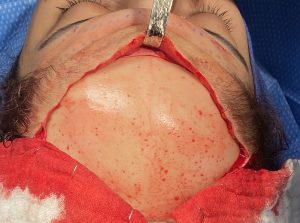Background: Reshaping the upper third of the face, as opposed to more commonly known rejuvenation techniques has a different objective and patient population. Forehead rejuvenation strives to make the upper face look less aged primarily by reduction of skin wrinkles and changing the position and arc of the eyebrows. Conversely the primary goal of forehead reshaping surgery is to change the surface contours and landmarks through various augmentation and reduction procedures. Often forehead rejuvenation procedures are done on younger patients while forehead rejuvenation is done on older patients with more advanced signs of aging.
In forehead reductive reshaping this could mean decreasing its vertical length through hairline lowering or even browlifts which are soft tissue changes. It could also mean reduction of undesired bony prominences usually through high speed burring tools. Some forehead reduction patients only get soft or bony tissue changes based on their aesthetic needs. But occasionally some patients have multiple forehead shape issues that require both bony and soft tissue alterations. If a frontal hairline advancement/lowering is to be done there is now open access to do any type of forehead bony reduction.





Key Points:
1) Options in forehead reduction surgery include both soft tissue and bony modifications.
2) Soft tissue modifications include decreasing forehead length through hairline lowering or eyebrow elevations.
3) Bony forehead reductions include treating horns, bossing or brow bone protrusions.
Dr. Barry Eppley
World-Renowned Plastic Surgeon







